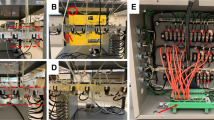Abstract
The present paper reports the development of novel braided structures using polyamide 6.6 fibers for application as artificial anterior cruciate ligaments (ACLs). The developed structures were circular braids, axially reinforced with either a number of core yarns or braided structures. Tensile behavior of these structures was characterized and the effects of number of axial yarns or braids and, the number of yarns used in the axial braids were thoroughly investigated. From the experimental results, it was observed that the braided structures with axial braids could mimic the load-elongation behaviour of native ACL. The average breaking extension and strain at toe region were 30 % and 4.3 % respectively, which are in the range of native ACLs. The maximum breaking force and stiffness achieved with 7 axial braids, each produced using 6 yarns were 274 N and 13.5 N/mm respectively and, both breaking force and stiffess showed linear increase with the number of axial braids as well as number of yarns used in the axial braids. Therefore, it is possible to design an artificial graft using these novel braided sturctures with mechanical properties similar to that of native ACLs, through adjustment of these structural parameters, as these braided structures have much smaller diameter (0.5 mm) than native ACLs (11 mm).
Similar content being viewed by others
References
J. Freeman, “Bone and Tissue Regeneration Insights — Tissue Engineering Options for Ligament Healing”, pp.13–23, Libertas Academica Ltd., 2009.
A. C. Vieira, R. M. Guedes, and A. T. Marques, J. Biomech., 42, 2421 (2009).
D. T. Gulick and H. N. Yoder, J. Sports Sci. Med., 1, 63 (2002).
C. Legnani, A. Ventura, C. Terzaghi, E. Borgo, and W. Albisetti, Int. Orthop., 34, 465 (2010).
D. L. Wise, D. J. Trantolo, D. E. Altobelli, M. J. Yaszemski, J. D. Gresser, and E. R. Schwartz in “Encyclopedic Handbook of Biomaterials and Bioengineering—Part A: Materials”, Marcel Dekker, New York, 1995.
F. H. Silver, J. W. Freeman, and G. P. Seehra, J. Biomech., 36, 1529 (2003).
C. T. Laurencin and J. W. Freeman, Biomaterials, 26, 7530 (2005).
L. Yahia, N. Hagemeister, G. Drouin, C. H. Rivard, S. Rhalmi, and N. Newman, “Ligaments and Ligamentoplasties”, p.57, Springer-Verlag, New York, 1996.
N. Chandrashekar, H. Mansouri, J. Slauterbeck, and J. Hashemi, J. Biomech., 39, 2943 (2006).
S. L. Y. Woo, J. M. Hollis, D. J. Adams, R. M. Lyon, and S. Takai, Am. J. Sports Med., 19, 217 (1991).
S. Karmani and T. Ember, Curr. Orthop., 17, 369 (2003).
P. S. Freudiger, Tech. Text. Int., 3, 12 (1994).
F. Noyes, D. Butler, E. Grood, R. Zernicke, and M. Hefti, J. Bone Joint Surg., 66-A, 344 (1984).
M. Tabrizian, A. Leroy-Gallisot, and L. Yahia, “Technical Report: Evaluation of Synthetic LARS Knee Ligaments”, pp.1–34, Biomechanics and Biomaterials Research Group, École Polytechnique de Montréal, 1996.
P. Potluri, A. Rawal, M. Rivaldi, and I. Porat, Compos. Part A, 34, 481 (2003).
J. A. Cooper, H. H. Lu, F. K. Ko, J. W. Freeman, and C. T. Laurencin, Biomaterials, 26, 1523 (2005).
H. Jadeja, D. Yeoh, M. Lal, and M. Mowbray, Knee, 14, 439 (2007).
P. Potluri, W. D. Cooke, A. L. Lamia, and E. C. Ortega, Journal of Textile and Apparel Technology and Management, 3, 1 (2003).
H. Jedda, S. B. Abdessalem, M. Ragoubi, and F. Sakli, J. Text. I., 99, 273 (2008).
J. A. Cooper Jr, J. S. Sahota, W. J. Gorum, J. Carter, S. B. Doty, and C. T. Laurencin. Proc. Natl. Acad. Sci. U. S. A., 104, 3049 (2007).
H. H. Lu, J. A. Cooper Jr, S. Manuel, J. W. Freeman, M. A. Attawia, F. K. Ko, and C. T. Laurencin, Biomaterials, 26, 4805 (2005).
J. W. Freeman, M. D. Woods, D. A. Cromer, L. D. Wright, and C. T. Laurencin, J. Biomater. Sci. Polym. Ed., 20, 1709 (2009).
J. W. Freeman, M. D. Woods, and C. T. Laurencin, J. Biomech., 40, 2029 (2007).
Author information
Authors and Affiliations
Corresponding author
Rights and permissions
About this article
Cite this article
Cruz, J., Rana, S., Fangueiro, R. et al. Designing artificial anterior cruciate ligaments based on novel fibrous structures. Fibers Polym 15, 181–186 (2014). https://doi.org/10.1007/s12221-014-0181-4
Received:
Revised:
Accepted:
Published:
Issue Date:
DOI: https://doi.org/10.1007/s12221-014-0181-4




